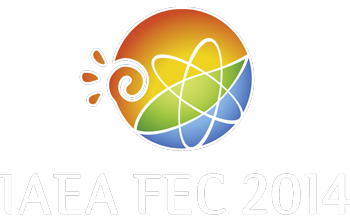Speaker
Mr
A. M. Garofalo
(USA)
Description
Recent experiments on DIII-D have overcome a long-standing limitation in accessing quiescent H-mode (QH-mode), a high confinement state of the plasma that does not exhibit the explosive instabilities associated with edge localized modes (ELMs). In the past, QH-mode was associated with low density operation, but has now been extended to high normalized densities compatible with operation envisioned for ITER. Through the use of strong shaping, QH-mode plasmas have been maintained at high densities, both absolute (bar{n}_e>7x10^{19}m^{-3}) and normalized Greenwald fraction bar{n}_e/n_G>0.7 . In these plasmas, the pedestal can evolve to very high pressures and current as the density is increased, becoming comparable to some of the highest performance transient pedestals seen on DIII-D. Calculations of the pedestal height and width from the EPED model are quantitatively consistent with the experimental observed evolution with density. Such comparisons of the dependence of the maximum density threshold for QH-mode with plasma shape help validate the underlying theoretical peeling-ballooning models describing ELM stability. High density QH-mode operation with strong shaping has allowed stable access to a previously predicted regime of very high pedestal dubbed “Super H-mode”. In general, QH-mode is found to achieve ELM-stable operation while maintaining adequate impurity exhaust, due to the enhanced impurity transport from an edge harmonic oscillation, thought to be a saturated kink-peeling mode driven by rotation shear. In addition, the impurity confinement time is not affected by rotation, even though the measured ExB shear is observed to increase at low toroidal rotation, resulting in reduced turbulence and increased energy confinement. Together with the simultaneous achievement of high beta, high confinement and low q95 for many energy confinement times, these results suggest QH-mode as a potentially attractive operating scenario for ITER’s Q=10 mission.
This work was supported by the US Department of Energy under DE-AC02-09CH11466 and DE-FC02-04ER54698.
| Country or International Organisation | USA |
|---|---|
| Paper Number | PPC/P2-37 |
Author
Dr
Wayne M. Solomon
(Princeton Plasma Physics Laboratory)
Co-authors
Mr
A. M. Garofalo
(USA)
Dr
Alberto Loarte
(ITER Organization)
Mr
B.A. Grierson
(Princeton Plasma Physics Laboratory)
Dr
Keith H. Burrell
(General Atomics)
Dr
Max Fenstermacher
(Lawrence Livermore National Laboratory)
Dr
Philip B. Snyder
(General Atomics)
Dr
Raffi Nazikian
(Princeton Plasma Physics Laboratory)

